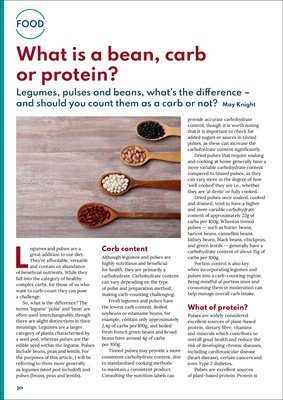
30
FOOD
What is a bean, carb
or protein?
Legumes, pulses and beans, what's the difference -
and should you count them as a carb or not? May Knight
Legumes and pulses are a
great addition to our diet.
They're affordable, versatile
and contain an abundance
of beneficial nutrients. While they
fall into the category of healthy
complex carbs, for those of us who
want to carb-count they can pose
a challenge.
So, what is the difference? The
terms 'legume' 'pulse' and 'bean' are
often used interchangeably, though
there are slight distinctions in their
meanings. Legumes are a larger
category of plants characterised by
a seed pod, whereas pulses are the
edible seed within the legume. Pulses
include beans, peas and lentils. For
the purposes of this article, I will be
referring to them more generally
as legumes (seed pod included) and
pulses (beans, peas and lentils).
Carb content
Although legumes and pulses are
highly nutritious and beneficial
for health, they are primarily a
carbohydrate. Carbohydrate content
can vary depending on the type
of pulse and preparation method,
making carb-counting challenging.
Fresh legumes and pulses have
the lowest carb content. Boiled
soybeans or edamame beans, for
example, contain only approximately
2.4g of carbs per 100g, and boiled
fresh french green beans and broad
beans have around 4g of carbs
per 100g.
Tinned pulses may provide a more
consistent carbohydrate content, due
to standardised cooking methods
to maintain a consistent product.
Consulting the nutrition labels can
provide accurate carbohydrate
content, though it is worth noting
that it is important to check for
added sugars or sauces in tinned
pulses, as these can increase the
carbohydrate content significantly.
Dried pulses that require soaking
and cooking at home generally have a
more variable carbohydrate content
compared to tinned pulses, as they
can vary more in the degree of how
'well cooked' they are i.e., whether
they are 'al dente' or fully cooked.
Dried pulses once soaked, cooked
and drained, tend to have a higher
and more variable carbohydrate
content of approximately 22g of
carbs per 100g. Whereas tinned
pulses -- such as butter beans,
haricot beans, cannellini beans,
kidney beans, black beans, chickpeas,
and green lentils -- generally have a
carbohydrate content of about 15g of
carbs per 100g.
Portion control is also key
when incorporating legumes and
pulses into a carb-counting regime.
Being mindful of portion sizes and
consuming them in moderation can
help manage overall carb intake.
What of protein?
Pulses are widely considered
excellent sources of plant-based
protein, dietary fibre, vitamins
and minerals which contribute to
overall good health and reduce the
risk of developing chronic diseases,
including cardiovascular disease
(heart disease), certain cancers and
even Type 2 diabetes.
Pulses are excellent sources
of plant-based protein. Protein is